How to Get Stain Out of White Comforter
To remove stains from your white comforter, first check the care label for washing instructions and fabric compatibility. Pre-treat the stain using a mixture of hydrogen peroxide and mild detergent, or apply a fabric-safe stain remover specifically designed for white fabrics. For organic stains like blood or coffee, use cold water treatment before applying cleaning solutions. Machine wash your comforter using gentle detergent and color-safe bleach on a bulky or delicate cycle, followed by thorough drying at low temperature with dryer balls. For stubborn marks, you might need enzymatic cleaners or specialty solutions. Beyond these basics, several advanced techniques can tackle even the most challenging stains.
This post may contain affiliate links. If you make a purchase through these links, I may earn a commission at no additional cost to you. Additionally, portions of this post may be generated using artificial intelligence (AI) technology. While we strive for accuracy, please be aware that AI-generated content may not always be perfect and should be fact-checked when necessary.
The Spatula Scoops
- Pre-treat stains immediately with cold water and stain remover spray, working from the outside toward the center of the stain.
- Mix hydrogen peroxide, dish soap, and baking soda into a paste for treating stubborn stains before washing.
- Machine wash using gentle detergent and color-safe bleach on bulky/delicate setting with an extra rinse cycle.
- For protein-based stains like blood, use cold water and enzymatic cleaners before machine washing.
- Dry on low heat with dryer balls, checking every 30 minutes to prevent overdrying and maintain fabric quality.
Common Types of Comforter Stains
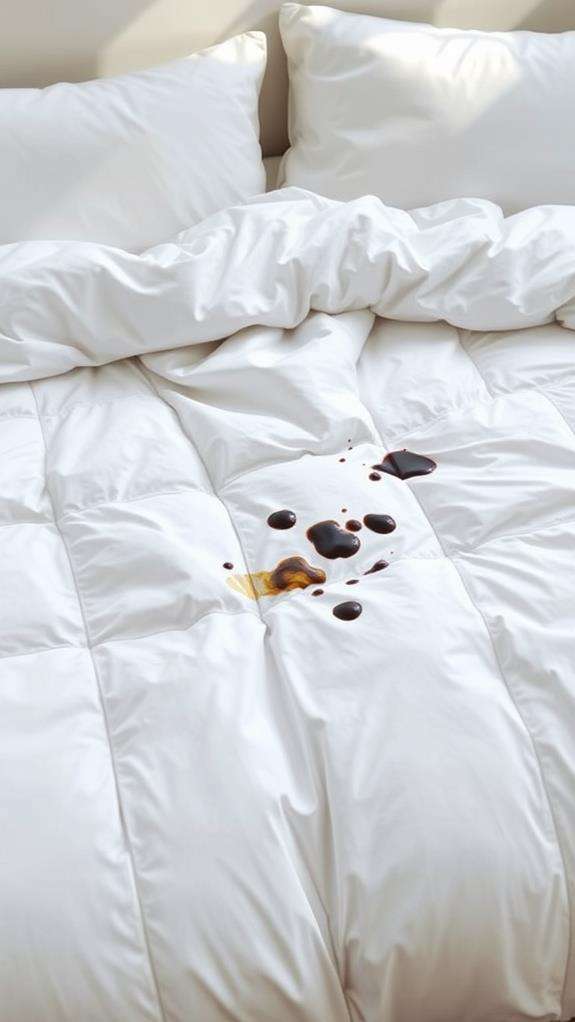
A white comforter can fall victim to various types of stubborn stains that'll test your cleaning skills. When you're dealing with a white comforter, you'll quickly notice that even the smallest spills become glaringly obvious, making prompt stain removal essential for maintaining its pristine appearance.
Food and beverage mishaps are among the most common culprits you'll encounter, with coffee and wine being particularly challenging to remove. You'll also frequently face grease stains, which can occur from late-night snacking or from natural body oils while you sleep. Sweat and other bodily fluids pose another significant challenge, as they can leave yellowish marks that become more noticeable over time.
Blood stains require special attention, and you'll want to tackle them immediately with cold water or hydrogen peroxide before they set into the fabric. Even clear liquids, such as water or soda, can leave visible rings on your white comforter if not addressed promptly. To maintain your comforter's appearance, you'll need to develop a quick response strategy for dealing with spills and establish a regular cleaning routine to prevent stains from becoming permanent fixtures.
Pre-Treatment Safety Guidelines
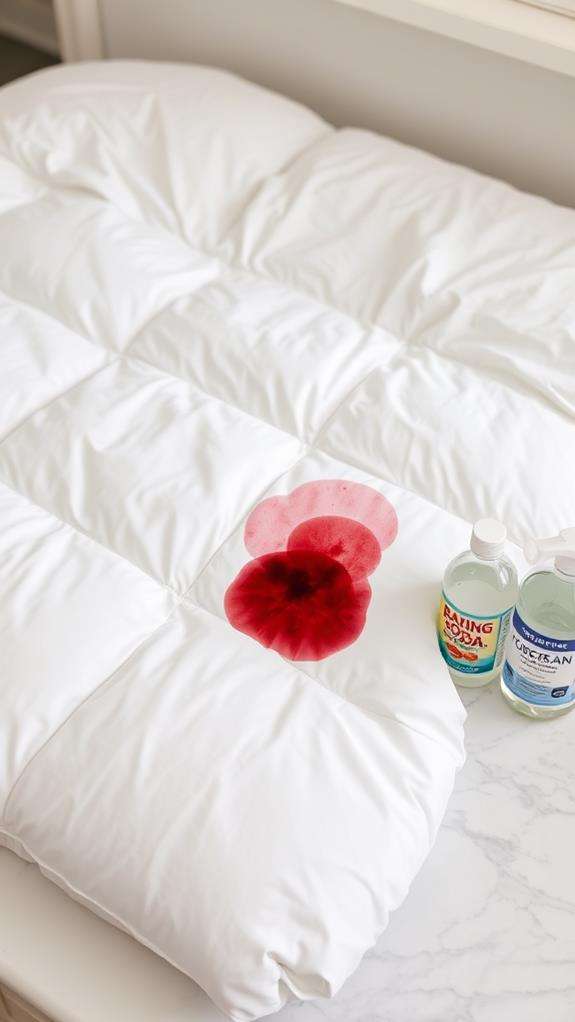
Before you start treating any stain on your white comforter, you'll need to carefully read the product labels and manufacturer's care instructions to guarantee safe, effective stain removal. It's also important to keep in mind safe storage tips for your cleaning products, as improper storage might lead to accidents. Keep all cleaning products in their original containers, stored away from children and pets, and never mix different cleaning chemicals, as this could create dangerous fumes. Additionally, consider the proper disposal of cleaning materials, similar to how one would handle safety and storage guidelines. When working with stain removers, especially bleach-based products, you'll want to open windows and doors for proper ventilation, and it's smart to wear gloves to protect your hands during the treatment process.
Read Labels First
The most critical step in treating stains on your white comforter starts with reading its care label. You'll find essential information about water temperature requirements, detergent recommendations, and specific cleaning restrictions that you'll need to follow to avoid damaging your comforter while treating the stained area.
Before you apply any cleaning solution or stain remover, check if your comforter is labeled "dry clean only." If it is, you'll want to take it to a professional cleaner rather than attempting to treat the stain yourself. For machine-washable comforters, pay close attention to the recommended water temperature, as using water that's too hot can set stains or damage delicate fibers. You'll also need to verify which type of bleach is safe to use, as many comforters require color-safe alternatives to traditional chlorine bleach.
Don't skip the vital step of testing any stain treatment product on a small, hidden area of your comforter first. This precautionary measure will help you avoid potentially ruining your comforter with harsh chemicals or inappropriate cleaning solutions that might cause discoloration or fabric damage.
Proper Chemical Storage
Safe chemical storage practices form the foundation of effective stain removal. When you're treating stains on your white comforter, you'll need to handle various cleaning agents responsibly to guarantee both safety and effectiveness. Always keep your stain removers in their original containers, making sure the labels remain intact and legible for future reference.
You'll want to create a dedicated storage space for your cleaning chemicals, ideally in a locked cabinet that's well out of reach of children and pets. Choose a cool, dry location away from direct sunlight, as exposure to heat and UV rays can compromise the effectiveness of your stain removers. If you're storing multiple cleaning products, never stack them directly on top of each other, as this could lead to accidental mixing if spills occur.
When you're ready to use your stain removers, work in a well-ventilated area, preferably near an open window or outdoors. Don't be tempted to mix different cleaning agents, even if you think it might boost their effectiveness. Each product is formulated to work independently, and combining them could create dangerous chemical reactions that put your safety at risk.
Ventilation During Treatment
Building on proper storage practices, maintaining good ventilation becomes your next key focus when treating stains on a white comforter. When you're ready to clean your comforter, start by opening all available windows in the room where you'll be working, creating a cross-breeze that'll help disperse any chemical fumes from cleaning agents.
If you're using strong cleaning solutions like hydrogen peroxide or bleach, you'll need to take extra precautions with ventilation. Position a fan near an open window to direct air outward, creating a steady flow that carries chemical vapors away from your workspace. Don't forget to wear a protective mask, especially if you have respiratory sensitivities or asthma. While you clean your comforter, make sure children and pets stay in another room until the cleaning process is complete and all fumes have dissipated. After applying any stain treatments, maintain proper airflow until the comforter is completely dry. This isn't just about comfort—proper ventilation prevents the development of musty odors and guarantees cleaning agents evaporate effectively, leading to better stain removal results.
Essential Cleaning Supplies
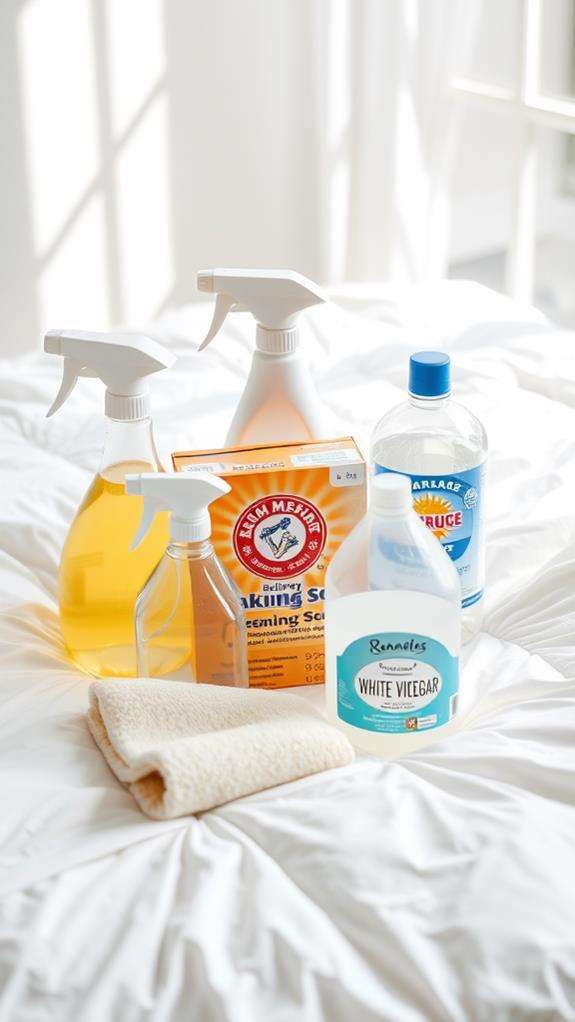
Your stain-fighting arsenal should include basic products like color-safe bleach and specialized laundry detergent, alongside a commercial stain remover that's specifically designed for your comforter's fabric type. You'll need practical tools for application, including clean white cloths for blotting and a spray bottle for even distribution of cleaning solutions, plus dryer balls for the final drying phase. A well-equipped cleaning station also benefits from having specialty solutions on hand, such as a DIY mixture of hydrogen peroxide and dish soap, which can tackle those particularly stubborn stains that won't budge with standard cleaners.
Basic Stain-Fighting Products
Getting your white comforter clean starts with stocking up on the right stain-fighting arsenal. You'll want to begin with a mild detergent specifically formulated for white fabrics, which helps maintain brightness while tackling tough stains. For enhanced cleaning power, keep hydrogen peroxide on hand, as it's particularly effective at removing organic stains without damaging the fabric's fibers.
When dealing with stubborn spots, you'll find oxygen bleach products like Clorox 2® invaluable, as they provide a safer alternative to harsh chlorine bleach while still delivering powerful stain-lifting results. Don't forget to include a stain remover pen or spray in your cleaning toolkit, which allows you to address spots immediately before they set into the fabric. For a natural approach, keep baking soda in your arsenal, as you can easily create a gentle cleaning paste by mixing it with water. This combination works particularly well on set-in stains that require a bit more attention. These basic stain-fighting products, when used correctly, will help maintain your white comforter's pristine appearance while effectively treating various types of stains.
Specialty Cleaning Solutions
Successful stain removal from a white comforter requires more than just basic cleaning products—you'll need a strategic combination of specialized solutions. To effectively tackle tough stains, start with a dedicated stain remover that's specifically formulated for your comforter's fabric type, ensuring you won't damage the material while treating the affected area.
One particularly versatile specialty solution you'll want to have on hand is hydrogen peroxide, which works wonders on stubborn stains like blood and wine. You can create an enhanced cleaning mixture by combining hydrogen peroxide with baking soda and a small amount of dish soap, forming a powerful stain-fighting paste. When applying any specialty solution, remember to use a clean, white cloth to prevent color transfer that could further complicate your cleaning efforts.
For the best results, you'll want to follow up your specialty treatments with a thorough washing process. Include an extra rinse cycle to remove all cleaning agents completely, and don't forget to add dryer balls during the drying phase—they'll help maintain your comforter's loft and prevent any filling from clumping together, ensuring your bedding returns to its original, pristine condition.
Tools For Application
Assembling the right tools before tackling stains on your white comforter will greatly improve your chances of success. You'll want to gather several essential items that work together to effectively remove stains while protecting your comforter's delicate fabric.
Start with a supply of clean, white cloths that you'll use for blotting and dabbing at stains, as colored cloths might transfer dye onto your white comforter. You'll need a gentle laundry detergent specifically formulated for delicate fabrics, along with a specialized stain remover designed for white textiles. Keep a bottle of hydrogen peroxide and dish soap nearby to create a powerful stain-fighting solution when needed. For the drying process, you'll want to have dryer balls ready to maintain your comforter's fluffiness and prevent unwanted clumping. Store these supplies in an easily accessible location, preferably in a dedicated cleaning caddy, so you can act quickly when stains occur. Remember to always test any new stain remover or cleaning solution on a small, inconspicuous area first to ascertain it won't damage your comforter's fabric.
Bleach Treatment Methods
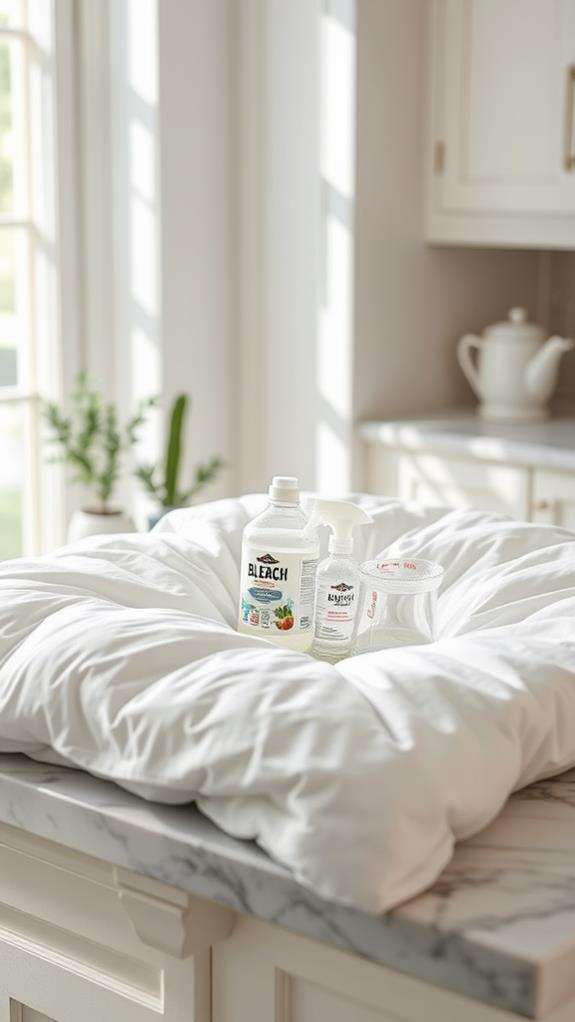
Bleach treatments offer a powerful solution for stubborn stains on white comforters, but you'll need to follow specific dilution guidelines to protect your bedding. Before starting any bleach treatment, always check your comforter's care label to confirm it's safe for bleach application, as some materials can become damaged even with diluted solutions.
For small stains, you'll want to create a properly diluted mixture of Clorox® Disinfecting Bleach and water. Apply this solution directly to the affected area and let it sit for the manufacturer's recommended time before washing. Don't make the common mistake of using undiluted bleach, as this can weaken or yellow your fabric.
When dealing with larger stains on down-filled comforters, opt for Clorox 2® for Colors mixed with water as a pretreatment solution. This gentler approach still provides effective stain removal while protecting your comforter's filling. After applying your chosen solution, you'll need to launder the comforter thoroughly according to its care instructions. Remember to maintain proper dilution ratios throughout the process, as this confirms both effective cleaning and fabric preservation.
Machine Washing Your White Comforter
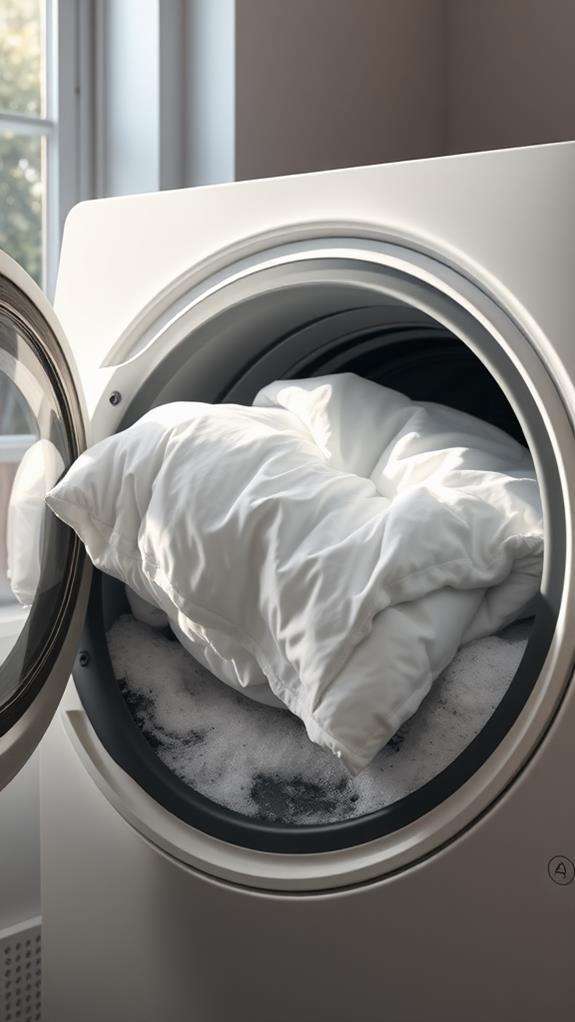
Once you've pretreated the stains, proper machine washing becomes your next step for a thoroughly clean comforter. Before you begin, carefully check the care label to confirm that your comforter can handle machine washing. You'll want to use a front-loading washing machine with adequate capacity to prevent damaging your comforter's filling.
For the best cleaning results, follow these essential steps:
- Load your comforter into the washing machine loosely, allowing enough space for proper agitation
- Add a gentle detergent and color-safe bleach if needed for stubborn stains
- Select the bulky or delicate setting, depending on your washing machine's options
Set your machine for an extra rinse cycle to guarantee all cleaning agents are completely removed from the fabric. This additional step prevents any residual detergent or bleach from yellowing your white comforter over time. When the wash cycle's complete, transfer your comforter to the dryer immediately. Use a low heat setting and add dryer balls to maintain the filling's loft and prevent clumping. This careful approach will help restore your comforter's pristine white appearance while preserving its quality.
Drying Techniques and Tips

Proper drying techniques play an imperative role in maintaining your white comforter's quality and appearance. You'll want to set your dryer to a low temperature setting to protect the fabric's integrity and prevent any potential damage. Adding dryer balls or clean tennis balls to the load will help maintain the comforter's loft while preventing the filling from clumping together.
| Drying Phase | Action Required | Significant Notes |
|---|---|---|
| Initial Setup | Add dryer balls | Use 3-4 balls minimum |
| Temperature | Set to low heat | Prevents fabric damage |
| Time Management | Check every 30 mins | Avoid overdrying |
| Moisture Check | Feel for damp spots | Focus on corners |
| Final Steps | Air dry if needed | Confirm completely dry |
If you notice that your comforter isn't completely dry after the first cycle, don't immediately start another high-heat cycle. Instead, consider laying it flat on a drying rack or hanging it on a clothesline to finish drying naturally. Regular moisture checks during the drying process are vital to prevent mildew formation. Before storing your comforter, make absolutely certain it's thoroughly dry to avoid musty odors and maintain its fresh appearance.
Stubborn Stain Solutions
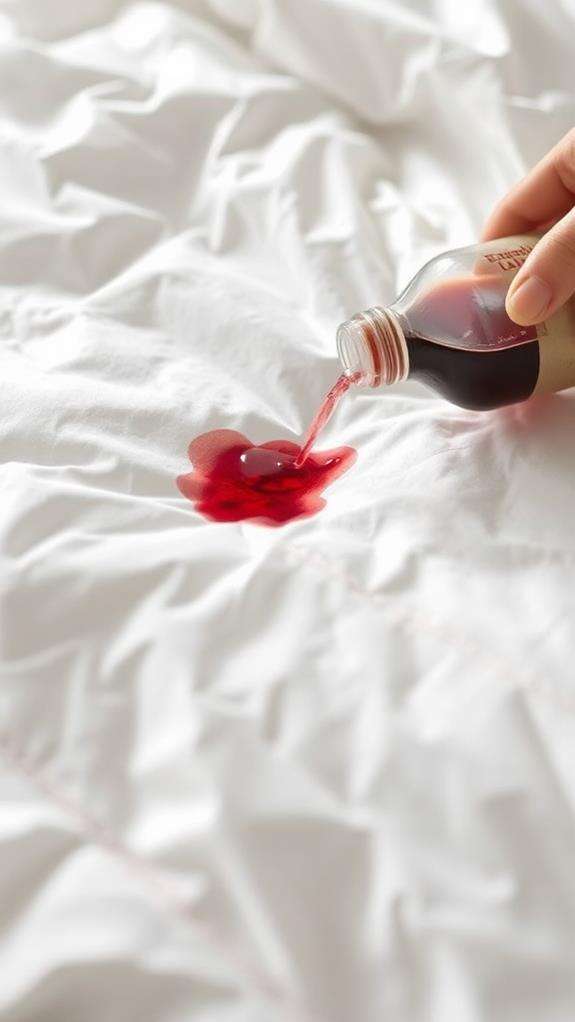
Tackling stubborn stains on your white comforter requires a strategic approach and the right combination of cleaning agents. Before attempting any treatment, you'll want to test your cleaning solution on an inconspicuous area to ascertain it won't damage the fabric. Additionally, consider that the overall environment and temperature can affect the stain removal process, similar to how a pillow requires specific care for ideal comfort breaking in a new pillow.
For particularly challenging stains, follow these proven methods:
- Coffee and wine stains: Mix hydrogen peroxide with dish soap in a 3:1 ratio, then apply a small amount directly to the stain. Gently work the solution into the fabric and let it sit for 30 minutes.
- Protein-based stains: Use cold water initially to prevent the stain from setting, then treat with hydrogen peroxide before washing normally.
- General tough stains: Create a paste using hydrogen peroxide, dish soap, and baking soda. Apply this mixture directly to the affected area.
When dealing with stubborn stains, always start by rinsing the area with cold water to prevent further setting. You'll want to be patient and allow any cleaning solution to work for at least 30 minutes before rinsing. Remember to avoid using hot water initially, as this can permanently set certain types of stains into the fabric.
Professional Cleaning Options
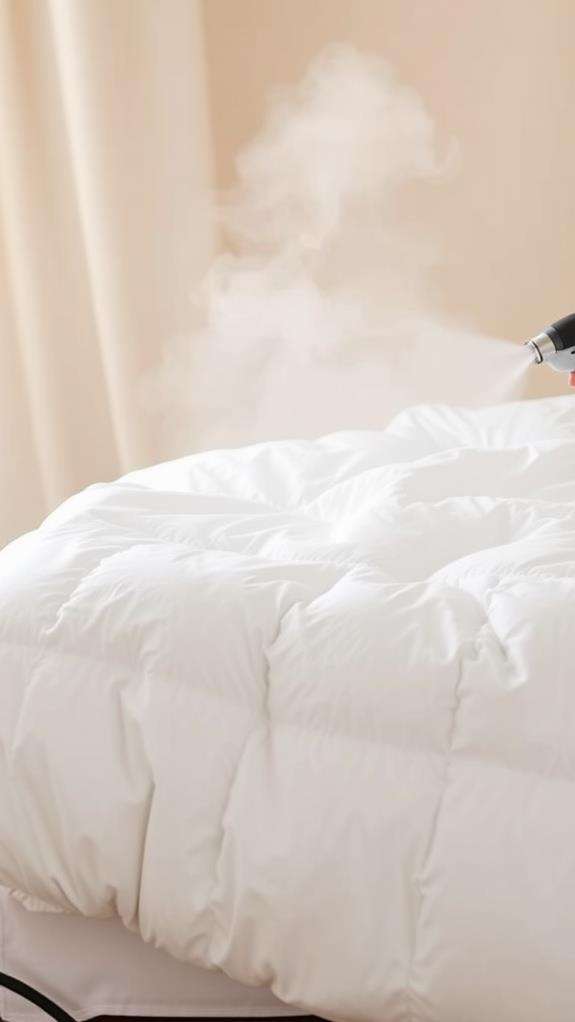
When home remedies fall short or you're dealing with particularly valuable comforters, professional cleaning services offer a reliable solution for stubborn stains. A reputable dry cleaner will assess your comforter's fabric content and stain type before determining the most effective cleaning approach, ensuring your bedding receives appropriate care.
Professional cleaning services employ specialized techniques that you won't find in typical home care methods. They'll help maintain shape and structure of your comforter while targeting tough stains with industrial-grade solutions. You'll find that these experts can effectively treat a wide range of stains without compromising the fabric's integrity or color brightness.
Consider scheduling a consultation with a dry cleaner to discuss your specific situation. They'll examine the stain, evaluate the fabric, and recommend the most suitable cleaning method. While this option may cost more than DIY solutions, it's often worth the investment for preserving expensive comforters. Regular professional maintenance can also prevent permanent damage and extend your comforter's lifespan, making it a cost-effective choice in the long run. Remember to mention any previous cleaning attempts when consulting with your cleaner, as this information helps them determine the best treatment approach.
Preventive Care Strategies

The best defense against stains on your white comforter comes down to smart preventive measures. By implementing effective preventive care strategies now, you'll markedly reduce the need for intensive cleaning later, keeping your comforter pristine for years to come. Regularly using a gentle laundry detergent formulated for down or feather comforters can also help preserve the fabric's quality. Consider utilizing washable protectors that not only block body oils and sweat but also make maintenance easier, especially given that body oils and sweat contribute to yellow stains.
To maximize your comforter's protection, consider these essential practices:
- Create protective barriers by using a top sheet and duvet cover, which act as your first line of defense against everyday wear and potential stains.
- Establish a strict no-food-in-bed policy, as this dramatically reduces the risk of accidental spills and stubborn stains.
- Keep your pets in their own beds, preventing fur, dander, and unexpected accidents from compromising your comforter's cleanliness.
You'll also want to develop a consistent hand-washing routine before touching your comforter, especially after meals or handling potentially staining substances. If you're concerned about oils and dirt transfer, consider placing a lightweight blanket beneath your comforter as an additional protective layer. These preventive measures might seem simple, but they're incredibly effective at maintaining your comforter's pristine white appearance and extending its lifespan.
Frequently Asked Questions
How to Make Comforter White Again?
To restore your comforter's whiteness, mix hydrogen peroxide, baking soda, and laundry detergent into a paste and apply it to problem areas. You'll want to soak the comforter in warm water with non-chlorine bleach, like Clorox 2®, to brighten the fabric. Don't forget to use dryer balls during drying, and make sure it's completely dry to prevent mold. For best results, wash your comforter every 1-3 months to maintain its bright white appearance.
How Do You Get Old Stains Out of White?
You'd think old stains are permanent, but they're not! Start by pre-treating the stain with oxygen bleach solution for 30 minutes. Apply a mixture of hydrogen peroxide and dish soap directly to the spot, gently working it into the fabric. For stubborn marks, create a paste using baking soda and water, letting it sit for 15 minutes. Finally, wash in hot water with a color-safe bleach and inspect before drying.
How Do You Get Stains Out of a White Blanket?
To remove stains from your white blanket, first rinse the affected area with cold water immediately after spotting the stain. Mix dish soap and hydrogen peroxide in a 3:1 ratio, then apply it directly to the stain. Gently blot (don't rub) with a clean white cloth. For protein-based stains, use hydrogen peroxide alone. You'll want to pre-treat the area before washing as usual, and always check the care label first.
How Do You Get Period Out of a White Comforter?
Ah, the classic "crimson surprise" on your pristine white comforter! Start by immediately rinsing the spot with cold water – hot water's your enemy here. Next, grab some hydrogen peroxide and dab it directly on the stain, letting it sit for 30 minutes. For stubborn spots, mix hydrogen peroxide with salt and dish soap to create a paste. Apply, wait, then wash in cold water. Still there? Repeat the process, and don't forget to air dry.





